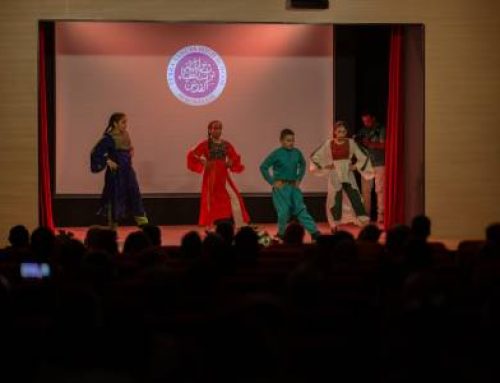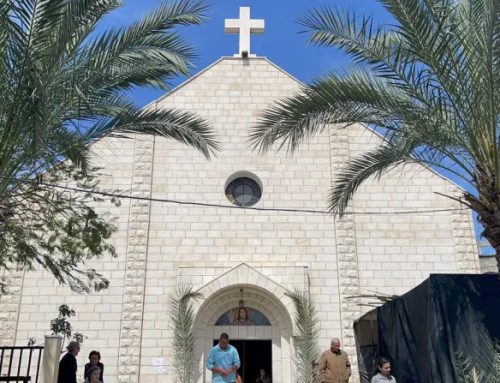The ruling by the International Court of Justice in The Hague Friday, calling Israel’s construction of its “Separation Wall” illegal, was greeted by hunger strikers in a tent on the northern outskirts of Jerusalem with more joy than a full-course meal would have brought.
The ruling by the International Court of Justice in The Hague Friday, calling Israel’s construction of its “Separation Wall” illegal, was greeted by hunger strikers in a tent on the northern outskirts of Jerusalem with more joy than a full-course meal would have brought.
The group hunger strike, called to bring attention to the humanitarian consequences of the Wall and led by Israeli-Arab Knesset member Doctor Azmi Bishara, began on July 3rd. Israelis, Palestinians and people from around the world, including members of the World Council of Churches’ Ecumenical Accompaniment Programme in Palestine and Israel (EAPPI), have joined the nonviolent action.
Churches in the US have also called on the US President George Bush to heed the court’s ruling.
“It gives us much hope,” Bishara said in reference to the International Court of Justice’s (ICJ) ruling. “We are starving here, but we are very hopeful. Now, it’s not just us saying that the Wall is illegal but the ICJ as well.” One of the specific points that the ICJ’s ruling drew attention to was the illegality of Israel constructing parts of its Wall on occupied Palestinian land rather than on its own internationally-recognized territory.
Bishara, one of two Christian members of the Knesset, Israel’s legislature, used the town of A-Ram as the base for his hunger strike for obvious reasons. Most of A-Ram’s 66,000 residents hold Jerusalem I.D.s and work in Jerusalem. Following the completion of the construction of the Wall, most will be denied access to Jerusalem and will therefore lose their livelihoods. The situation in A-Ram is similar to that of many communities throughout the West Bank and East Jerusalem.
“We want to make it clear that this Wall means life and death for Jerusalem and the whole of Palestinian society,” Bishara continued. “We have used all the parliamentary tools and we will continue to use them. But that has not been enough to show the severity of the situation. This is not only about apartheid, separating Israelis from Palestinians. It’s also about annexation of land, separating Palestinians from Palestinians and getting rid of Palestinians. For Palestinian society, the Wall is absolutely destructive because it separates families and destroys economic and cultural life and people’s ability to go to school and work.”
The hunger strike, the same type of nonviolent method used by Mohandas Gandhi over 50 years ago, has been criticized by some as too drastic a measure. Bishara rejected any such notion: “The situation is drastic, but nobody is doing anything. Now, I’m using my position to draw attention to it. The world can’t just overlook the situation anymore; they have to do something as well. And we will not be happy only with a condemnation on the building of the Wall.”
Bishara’s initiative has been supported by people from across Palestinian and Israeli religious and secular society as well as by members of the international community. Others joining in the hunger strike have included: Archimandrite Atallah Hanna, a Palestinian in the Greek Orthodox Church; Sheikh Tayseer Tamimi, chief judge of the Islamic Supreme Sharia’a Court; and Michael Warchawski, an Israeli and Co-chair of the joint Palestinian-Israeli Alternative Information Center. Many members of the Palestinian Legislative Council joined in the hunger strike as well. Also present in the tent, showing their support, were representatives of the Druze community from the Golan Heights, which was annexed by Israel from Syria following the 1967 war.
Members of the EAPPI, whose mission is to accompany Palestinians and Israelis in their nonviolent actions and concerted advocacy efforts to end the occupation, were also present at the tent in A-Ram to show solidarity with the hunger strikers and also to participate in the action. Ecumenical Accompaniers Matt Robson of the United Kingdom, Martin Smedjeback of Sweden and Motlatsi Xhalabile of South Africa participated in the hunger strike for one day to show their support for the effort.
Said Robson: “I lost count of the number of people who came up and thanked me for being here; for joining in the hunger strike; and for showing my opposition to this eight-meter high concrete monstrosity that will change their lives if it is completed. That was all the nourishment I needed.”
The organizers of the hunger strike planned a mass demonstration at the tent following the Friday Muslim noon prayer to coincide with the announcement of the ICJ’s ruling. A large contingent from the EAPPI was present, including two more Accompaniers from South Africa, which is participating in the program for the first time. The South African Accompaniers, Wandile Kuse, an Anglican priest, and Hermina Damons, were particularly well-received as they offer a symbol of what can be achieved in this the 10-year anniversary of the end of apartheid in that country. Kuse and Damons both addressed the gathering.
“In the 1930s, the white people in South Africa took 87% of the land, although they represented just one quarter of the population,” Kuse said. “Now we see some of the same things happening here. We got support from the whole international society. Now it’s your turn to be entitled to the same international support.”
“Much of what we’ve seen here the last two weeks is the same as we experienced in South Africa,” Damons said in her address. “We’re here now to encourage you to continue your struggle for justice.”
The symbolic appeal represented by visitors from South Africa to those struggling against the occupation here is not lost on Kuse or Damons. Said Kuse: “We feel we are bringing a message of hope. This occupation will not last forever, despite evidence to the contrary. There was a time when things looked impossible in South Africa too. But if it (the end of apartheid) happened to us, it could happen to them.”
Added Damons: “We can feel what they are feeling. More than just understanding it, we can feel it.”
The tent is a beehive of activity with a constant flow of people coming in and out. Politicians, muftis, sheiks, priests, relatives and friends, and people from abroad come in to show their support for the hunger strikers. The mood is almost festive, but the difficulty of the demonstration is evident when one of the hunger strikers becomes a bit irritated as he finds a bag of grapes in the tent, inadvertently brought in by someone. No food is allowed in the tent, of course, out of respect for those fasting. Suheil Khader, the deputy mayor of A-Ram, wound up in a hospital after participating in a hunger strike for 16 days in 1981. “We are ready to sacrifice ourselves for peace; for the love between people,” he said. “I am tired but when I speak about the suffering of my people, I forget my own personal suffering. The suffering of the people of Palestine is bigger than the suffering of my empty stomach.”
According to Khader, the real reason for the route the Wall is taking in Jerusalem is to force Palestinians to move and give up their rights as Jerusalem residents. “I can’t afford a ,000 a month apartment in Jerusalem so I’m forced to give up my Jerusalem I.D.,” Khader explains. “This is their (the Israeli government) way to make Palestinians leave Jerusalem.”
Based on Israel’s current plans, when the Wall is completed it will be five times longer than the Berlin Wall was and in some places twice as high. Many nonviolent demonstrations against the Wall’s construction have been held but they have received little attention outside of Palestinian circles, particularly in the West. “We know we have right on our side, but it is not enough in this world,” said Ahmad Ghneim, a member of the high committee of the Fatah political movement. “You also need to find the right tools to express your rights.”
Israel, in arguing against accusations that the real purpose of the Wall is to confiscate rich agricultural land and valuable underground water resources around settlements, has stated repeatedly that the barrier is necessary for security. The example of Gaza, where a fence was constructed, is often cited as proof of the efficacy of the barriers. Bishara turns that argument on its head: “If security is ensured by the fence in Gaza, why is it the most bombarded city in the world? Is this a successful model? Is this what is in store for the West Bank? Just as in Gaza, people will find other ways to resist. You can’t take the land, then the water, and then say, ‘You are behind the Wall, now it’s your problem.’ That will not guarantee security.”
The entire gathering was aware of the decision the ICJ had reached, the news having leaked out the night before. But the official announcement provided hope in a sometimes hopeless situation. That hope was tempered somewhat by the realistic knowledge that Israel had already stated it did not recognize the ICJ’s jurisdiction in the matter and that the United States had already given strong indications it would veto any possible action in the United Nations Security Council. With those developments as a backdrop, Bishara said the hunger strike would continue indefinitely with the understanding that many obstacles still remain before the Wall is stopped.





